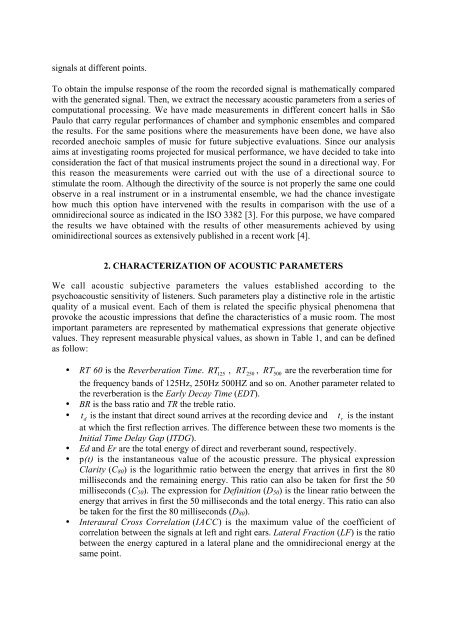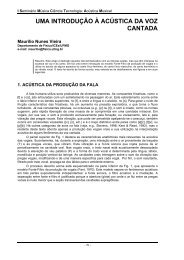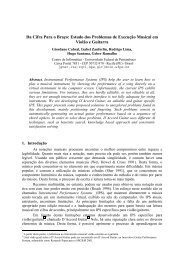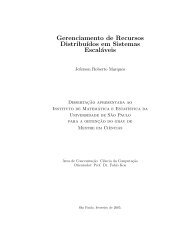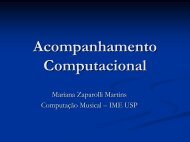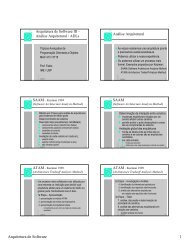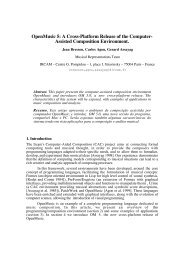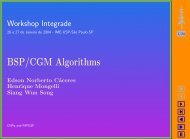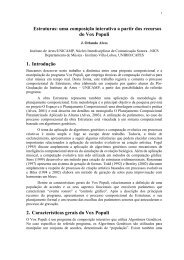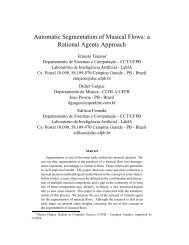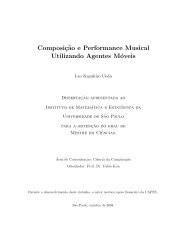Comparative study of measured acoustic parameters in concert halls ...
Comparative study of measured acoustic parameters in concert halls ...
Comparative study of measured acoustic parameters in concert halls ...
You also want an ePaper? Increase the reach of your titles
YUMPU automatically turns print PDFs into web optimized ePapers that Google loves.
signals at different po<strong>in</strong>ts.<br />
To obta<strong>in</strong> the impulse response <strong>of</strong> the room the recorded signal is mathematically compared<br />
with the generated signal. Then, we extract the necessary <strong>acoustic</strong> <strong>parameters</strong> from a series <strong>of</strong><br />
computational process<strong>in</strong>g. We have made measurements <strong>in</strong> different <strong>concert</strong> <strong>halls</strong> <strong>in</strong> São<br />
Paulo that carry regular performances <strong>of</strong> chamber and symphonic ensembles and compared<br />
the results. For the same positions where the measurements have been done, we have also<br />
recorded anechoic samples <strong>of</strong> music for future subjective evaluations. S<strong>in</strong>ce our analysis<br />
aims at <strong>in</strong>vestigat<strong>in</strong>g rooms projected for musical performance, we have decided to take <strong>in</strong>to<br />
consideration the fact <strong>of</strong> that musical <strong>in</strong>struments project the sound <strong>in</strong> a directional way. For<br />
this reason the measurements were carried out with the use <strong>of</strong> a directional source to<br />
stimulate the room. Although the directivity <strong>of</strong> the source is not properly the same one could<br />
observe <strong>in</strong> a real <strong>in</strong>strument or <strong>in</strong> a <strong>in</strong>strumental ensemble, we had the chance <strong>in</strong>vestigate<br />
how much this option have <strong>in</strong>tervened with the results <strong>in</strong> comparison with the use <strong>of</strong> a<br />
omnidirecional source as <strong>in</strong>dicated <strong>in</strong> the ISO 3382 [3]. For this purpose, we have compared<br />
the results we have obta<strong>in</strong>ed with the results <strong>of</strong> other measurements achieved by us<strong>in</strong>g<br />
om<strong>in</strong>idirectional sources as extensively published <strong>in</strong> a recent work [4].<br />
2. CHARACTERIZATION OF ACOUSTIC PARAMETERS<br />
We call <strong>acoustic</strong> subjective <strong>parameters</strong> the values established accord<strong>in</strong>g to the<br />
psycho<strong>acoustic</strong> sensitivity <strong>of</strong> listeners. Such <strong>parameters</strong> play a dist<strong>in</strong>ctive role <strong>in</strong> the artistic<br />
quality <strong>of</strong> a musical event. Each <strong>of</strong> them is related the specific physical phenomena that<br />
provoke the <strong>acoustic</strong> impressions that def<strong>in</strong>e the characteristics <strong>of</strong> a music room. The most<br />
important <strong>parameters</strong> are represented by mathematical expressions that generate objective<br />
values. They represent measurable physical values, as shown <strong>in</strong> Table 1, and can be def<strong>in</strong>ed<br />
as follow:<br />
€<br />
• RT 60 is the Reverberation Time. RT 125<br />
, RT<br />
250<br />
, RT<br />
500<br />
are the reverberation time for<br />
the frequency bands <strong>of</strong> 125Hz, 250Hz 500HZ and so on. Another parameter related to<br />
the reverberation is the Early Decay Time (EDT).<br />
• BR is the bass ratio and TR the treble ratio.<br />
€<br />
• t d<br />
is the <strong>in</strong>stant that direct sound arrives at the record<strong>in</strong>g device and t<br />
r<br />
is the <strong>in</strong>stant<br />
at which the first reflection arrives. The difference between these two moments is the<br />
Initial Time Delay Gap (ITDG).<br />
• Ed and Er are the total energy <strong>of</strong> direct and reverberant sound, respectively.<br />
• p(t) is the <strong>in</strong>stantaneous value <strong>of</strong> the <strong>acoustic</strong> pressure. The physical expression<br />
Clarity (C 80 ) is the logarithmic ratio between the energy that arrives <strong>in</strong> first the 80<br />
milliseconds and the rema<strong>in</strong><strong>in</strong>g energy. This ratio can also be taken for first the 50<br />
milliseconds (C 50 ). The expression for Def<strong>in</strong>ition (D 50 ) is the l<strong>in</strong>ear ratio between the<br />
energy that arrives <strong>in</strong> first the 50 milliseconds and the total energy. This ratio can also<br />
be taken for the first the 80 milliseconds (D 80 ).<br />
• Interaural Cross Correlation (IACC) is the maximum value <strong>of</strong> the coefficient <strong>of</strong><br />
correlation between the signals at left and right ears. Lateral Fraction (LF) is the ratio<br />
between the energy captured <strong>in</strong> a lateral plane and the omnidirecional energy at the<br />
same po<strong>in</strong>t.


